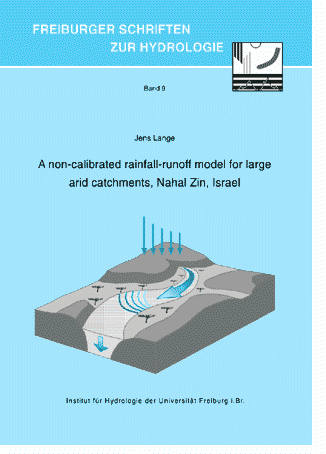|

Freiburger Schriften zur Hydrologie
 |
[ << Band/volume 8 ] [
Freiburger Schriften zur Hydrologie ] [
>> Band/volume 10 ]

Band/volume 9: LANGE J. (1999):
A non-calibrated rainfall-runoff model for large arid catchments, Nahal
Zin, Israel
 Much field based
hydrological research has been conducted in arid environments mainly in microscale
studies. Two main processes dominate arid zone flood generation: (a) the generation and
spatial concentration of surface runoff as a direct response to localized high intensity
rainfall and (b) transmission losses into the dry channel alluvium. The present study
seeks to incorporate this knowledge into a rigorous analysis of single high magnitude
events in a large arid catchment. This required a new appropriate tool, i.e. a
rainfall-runoff model not depending on calibration with hydrometric streamflow data. Much field based
hydrological research has been conducted in arid environments mainly in microscale
studies. Two main processes dominate arid zone flood generation: (a) the generation and
spatial concentration of surface runoff as a direct response to localized high intensity
rainfall and (b) transmission losses into the dry channel alluvium. The present study
seeks to incorporate this knowledge into a rigorous analysis of single high magnitude
events in a large arid catchment. This required a new appropriate tool, i.e. a
rainfall-runoff model not depending on calibration with hydrometric streamflow data.
The model uses spatially distributed rainfall input applied over a catchment which is
disaggregated into different terrain types according to hydrologically relevant surface
characteristics. Inside the channel network the MVPMC3-method of the Muskingum-Cunge
technique is used for streamflow routing accounting for channel dimensions and roughness.
For each channel segment a constant infiltration rate is applied to account for
transmission losses and discontinued when the wetting front reached the bottom of the
available alluvial storage.
In the Zin catchment, Negev Desert, Israel, neither of the two large floods used for
model application was completely documented. For both of them the model helped to analyze
flood generation: In the uppermost catchment a localized, convective rainstorm caused the
high magnitude flood of October 1979. Areas of major cell activity and runoff generation
could be reasonably reconstructed by a reversed use of the Zin model as a 'runoff-rainfall
model'. For the October 1991 event data from six rainfall recorders and a rainfall radar
were available. However, gauging stations were destroyed and peak discharges had to be
reconstructed post-factum. The fit of the peak discharges was encouraging as simulations
fell within the uncertainty range of reconstructed field values. The postponed response of
an upper tributary directly sharpened the main flood peak. Then the peak did not decrease
significantly downstream. Preceding inflows from tributaries caused an initial wetting of
the alluvium. The following main flood crossed over a nearly saturated channel alluvium
with a high flow velocity. Hence the effect of transmission losses on flood peaks may be
limited when additional parts of a catchment are active.
Total maximum model uncertainty was estimated including the uncertainty
ranges of each model parameter. The different event characteristics directly
affected parameter sensitivity and model uncertainty. Maximum model parameter
error of the diminished October 1979 peak was governed by transmission
loss parameters and exceeded 300 %. During 1991 only 90 % was determined
for this value and infiltration characteristics of the terrain were more
relevant. Still comparisons to existing calibrated or regionalized models
showed that the present approach may be regarded as superior when runoff
responses (e.g. rare high magnitude discharges) and flow processes (e.g.
concentration times and flow velocities) are simulated in conditions or
areas where no field data exist. Hence the model may be reasonably applied
to ungauged catchments simulating the dangers and benefits of desert floods.
This may yield a more dependable flood control (i.e. a 'field based estimate'
of extreme discharges and flood concentration times) and estimates of
runoff volumes available for groundwater recharge at the mouth of large
dryland rivers.
[ deutsche Zusammenfassung ]
[ more information ]
PDF-Download (8,2 MB)
|

